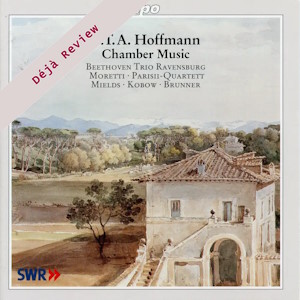
Déjà Review: this review was first published in November 2003 and the recording is still available.
E.T.A. Hoffmann (1776-1822)
Chamber Music
Grand Piano Trio in E major (1809)
6 Italian Duets for Soprano, Tenor and Piano (1812)
Harp Quintet in C minor (1805-1807)
Dorothee Mields (soprano), Jan Kobow (tenor)
Wolfgang Brunner (piano)
Isabelle Moretti (harp)
Beethoven Trio Ravensburg
Parisii-Quartett
rec. 1995-2001, SWR, Hans-Rosbaud-Studio, Baden-Baden, Germany
cpo 9993092 [55]
E.T.A. Hoffmann was a ‘man for all seasons’. In addition to composing music, he was an illustrator, writer, and attorney who attained a position on the Court of Appeals in Berlin. His primary legacy is in the area of German literature. He wrote many novels and stories concerned with supernatural elements and their impact on humans. Hoffmann’s most famous writings are the stories on which the French composer Jacques Offenbach based his opera “Tales of Hoffmann”.
When I read a Hoffmann story, I think of the supernatural operas of Carl Maria von Weber, not Hoffmann’s most well known opera “Undine”. The fact is that Hoffmann’s reputation as a composer is slight, and recordings of his works are infrequent. Even during his own lifetime, he had great trouble getting his music published.
Personally, I find Hoffmann’s musical obscurity a bit extreme. “Undine” is an excellent opera in the German Romantic tradition, and the three chamber works on the new CPO disc are testimony to Hoffmann’s ability to compose well-structured music that expertly blends the different instruments and offers ample variety. Of course, there are many dozens of other composers of Hoffmann’s era who also composed attractive music. Some of them, including Carl Maria von Weber, significantly surpass Hoffmann in musical invention.
The question is whether the works on the CPO disc warrant your attention. One of them definitely commands your attention, and it is the Grand Piano Trio. Right from the first few bars of the 1st Movement Allegro moderato, Hoffmann asserts himself splendidly with tuneful phrases intricately tied together and a vitality and zest for life that is irresistible. The piece unfolds naturally and is delightful listening.
Attractive music making continues with the 2nd Movement Scherzo in the key of E minor. Much of the Scherzo is perpetual motion and quite exciting with dotted rhythms and jagged edges. The 3rd Movement Adagio is a short one of only twenty-three measures but well establishes its comfort and glowing warmth. The Adagio also represents an introduction to the 4th Movement Allegro vivace as it routinely changes key signatures until leading into the final movement’s E major domain. As would be expected, the 4th Movement is energetic and perky, although some angst enters the musical landscape for contrast. Overall, the Grand Trio is an excellent piece of music that compares well to the chamber music of Spohr and Hummel, and the Beethoven Trio Ravensburg plays the work with a vivacious and alert quality that adds up to an outstanding performance by the ensemble.
Hoffmann’s Harp Quintet is a fine three-movement composition of slightly lower quality than the Grand Piano Trio. However, I have reservations concerning the demure projection of the harp in the 1st Movement Allegro moderato. Isabelle Moretti simply doesn’t offer the vitality expressed by the Parisii-Quartett, and I find this somewhat odd given that she is fully energized for the 3rd Movement Allegro.
I am less enamored of the Duets. Each of the songs has a maudlin flavor with the same basic theme that “only with you can I be happy”. These songs remind me of Mozart’s, but at a much-reduced level of inspiration. Further, although the tenor Jan Kowbow has a moderately attractive voice, I don’t feel it meshes well with the gorgeous tone of Dorothee Mields; actually, I find Kowbow an annoying distraction from the many pleasures to be had from Mields.
In summary, this new Hoffmann chamber music disc has much to offer to those who enjoy classically oriented music from the early 1800s. The Italian Duets are not very appealing, but they take up less than 15 minutes of music. Recorded sound is superb and particularly flattering to the vivid projection of the stringed instruments.
I should warn that anyone expecting music along the lines of the romantic opera “Undine” will be surprised by the restraint and elegance of Hoffmann’s chamber music that clearly is associated with the Classical period. If the chamber works of Hummel and Spohr are appealing, Hoffmann can safely be added to one’s music library. Not an essential acquisition by any means, but attractive music to add to the evening’s entertainment.
Don Satz
Buying this recording via a link below generates revenue for MWI, which helps the site remain free




















